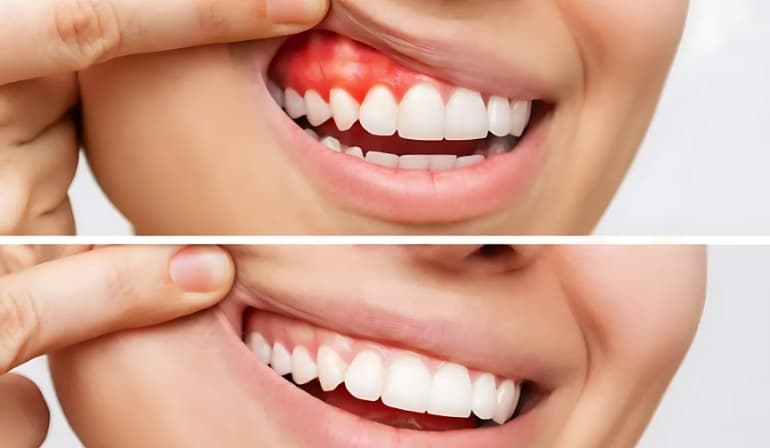Gum Disease Treatment in Texas
CONTACT US
Book Your Appointment
You will receive your appointment confirmation soon.
All Service:
- Cosmetic Dentistry
- General Dentistry
- Orthodontics
- Periodontal Treatment
- Dental Implants
- Teeth Whitening
- Family Dentistry
- Root Canal
- Wisdom Teeth and Sedation
- Pediatric Dentistry
- Restorative Dentistry
- Gum Disease Treatment
- Dental Emergencies
- Dental Bonding
- Tooth Extraction
- Dental Crown
- Dental Bridge
- Dental Sealants
- Invisalign
- Dental Fillings

Periodontal disease, sometimes known as gum disease, is an infection and inflammation of the tissues supporting your teeth. Gum disease can result from poor dental care. Some people are more prone to this issue even with thorough flossing and brushing. Periodontal disease is an infection of the gums and bone meant to support your teeth. Although some people are more susceptible, poor hygiene can lead to it. Symptoms include loose teeth, bad breath, swelling, bleeding gums.
How do Dentists Diagnose Gum Disease?
During a regular checkup, a dentist can spot gum disease. They will inquire about symptoms and inspect your teeth for plaque. A periodontist may recommend a therapist and evaluation.
- A dentist or periodontist measures tooth pockets using a periodontal probe. This indicates the amount of bone you have lost around your teeth.
- Deeper pockets indicate more serious gum disease. Your periodontist will examine your bite, tooth looseness for gum recession treatment.
- Dental X-rays are also taken. These photos detail bone loss. They can also examine older X-rays to discover bone changes.
Is Periodontal Disease Curable?
With proper periodontal therapy, gum disease is controllable but not curable. Because you rarely regain structural support around your teeth, you can’t fix it. Dentist gum disease treatment can minimize infection and repair bone and tissue. Another influence is genetics. Oral bacteria vary. Some individuals are predisposed to gum disease. Gingivitis is entirely reversible. Consistent dental cleaning and oral hygiene can reverse gingivitis if detected early.
Gum Disease Treatments
Following are the effective gum disease treatments:
Scaling and Root Planing
Root planing and scaling is like dental cleaning. But it eliminates plaque and germs behind your gums where your floss and toothbrush can not reach. Periodontists in Texas recommend scaling and root planing therapy for mild gum disease. A dental hygienist scales debris from your teeth and planes your root surfaces to prevent bacteria from reattaching. They use a local anesthetic for at least two visits.
Pocket Reduction Surgery
For mild to advanced gum disease, osseous pocket reduction surgical gum treatment may be necessary. Your hygienist can’t reach deep under the gums to remove plaque and tartar. A periodontist of dental clinics for gum treatment Texas cuts and flaps your gums during this treatment. They temporarily shift your gums away from your dental roots. They will then clean any rough patches and remove plaque, tartar, and germs from your tooth roots. Once finished, they will sew the cut and realign your gums. Periodontists for gum disease treatment in Texas often mix pocket reduction surgery with bone, gum, or directed tissue regeneration.
Laser-Assisted New Attachment
Some periodontists use LANAP to reduce pockets. Periodontitis is treated with a portable laser that is a non surgical gum disease treatment. The laser targets sick gum tissue while preserving healthy tissue. Traditional pocket reduction surgery is more intrusive than LANAP. The outcomes are mixed.
Bone Grafting
Your periodontist may utilize the best gum disease treatment that is a dental bone graft to replace gum disease. After gum infection management, they’ll fill the bone-degraded places using bone grafts. This framework or space-holder lets your body repair bone.
Grafting Gum
Affordable periodontists in Texas may offer gum graft surgery, sometimes termed tissue grafting, if you’ve lost gum tissue to periodontal disease. This surgery thickens gums and hides exposed dental roots. Periodontists add tissue to gum recession sites during this treatment. Your clinician may use the roof of the mouth tissue or buy it from a licensed bone and tissue bank.
Guided Tissue Regeneration
Guided tissue regeneration and bone grafts are typical periodontal treatments. GTR heals periodontal abnormalities and prevents soft tissue growth. GTR involves a periodontist placing an artificial membrane between your gums and bone grafting material. The membrane keeps that gap open so bone can form instead of soft tissue, which regenerates faster.
PRF and PRP
Growth factors in PRF and PRP accelerate tissue regeneration and repair. Your gum disease dentist Texas can get PRF and PRP from a tiny blood sample. They’ll use a centrifuge to separate plasma from red blood cells. This treatment accelerates rehabilitation, soothes post-surgical pain, and enhances healing. It’s your blood; therefore, it’s safe.
Your Best Solution to Gum Disease
Early on, periodontal disease is rarely agonizing. Having the indications helps you get treatment before the condition advances. Neglected gum disease can damage your general health as well as your dental health. The infection can spread to other parts of your mouth and body, increasing your risk of heart disease, stroke, and diabetes. Swollen, painful, or bleeding gums should be reported to the periodontists clinic in Dallas. They can get rid of infection and bring back healthy gums and teeth. We have the Texas best dentist to halt and reverse gum disease. We will customize a treatment to fit your dental health.
